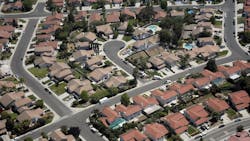Where is the Housing Market Headed?
The U.S. housing market is expected to face another tough year in 2026, with new tariffs likely slowing economic growth and pushing inflation higher. However, a stronger economy and falling mortgage rates are projected to boost housing affordability and drive a rebound in new residential construction between 2027 and 2029, according to a recently released housing forecast from investment research and data platform Morningstar.
Rentership is expected to continue gaining traction as home prices grow
As of the end of the Q-2 2025, the number of owner-occupied homes stood at 86.2 million, holding steady compared with the previous year. Meanwhile, renter-occupied units rose to 46.4 million, marking a 2.7% increase year-over-year.
These figures are not expected to improve much as household growth declines. It is expected that the housing market will see the addition of 1.2 million new households in 2025. This is less than the 1.4 million added in 2024 and the 1.8 million average from 2018 to 2023. Additionally, most of these new households are expected to be renters.
Even though rentership is expected to rise, homebuyers are adjusting to higher rates
Sales of existing homes have fallen for three straight years. In 2024, 4.06 million homes were sold, down 34% from 2021 and more than 20% below the 25-year average of 5.2 million. So far in 2025, existing-home sales are slightly behind last year’s pace, with sales through August down by about 1%. That said, another yearly decline in sales isn’t guaranteed, especially if mortgage rates begin to ease later in the year.
On the other hand, the new-home market is already showing signs of recovery. Builders have been using price incentives and mortgage rate buydowns to attract buyers, leading to a 4% increase in new-home sales in 2023 and another 3% gain in 2024.
More new homes are on the way, but the supply is shrinking
As of August, about 1.33 million homes were under construction, including 630,000 single-family and 700,000 multifamily units. While August’s figure is still 23% below the 2022 peak of 1.73 million units under construction, it's still above pre-pandemic levels, which averaged 1.1 million units from 2017 through 2019.
Single-family housing starts rose 7% in 2024, driven by builders ramping up construction of speculative homes and offering buyer incentives. However, by August 2025, starts had fallen 5% compared with the previous year, as demand softened and a growing number of completed but unsold homes prompted builders to slow down. Still, the backlog of single-family homes under construction remains high, with over 600,000 units in progress.
Where is the housing market headed next?
Looking ahead to 2026, the housing market is expected to remain under pressure, but that could change over the following years. In 2026, the report suggests that single-family starts will decline another 2% while multifamily housing starts fall by 16% due to slow economic growth and inflation.
However, a longer-term recovery is expected. As the economy improves and mortgage rates drop, housing affordability should increase. This could lead to a surge in new construction from 2027 to 2029, according to the report, particularly as younger Americans enter the market. Over the next decade, housing starts are projected to average around 1.5 million per year.
